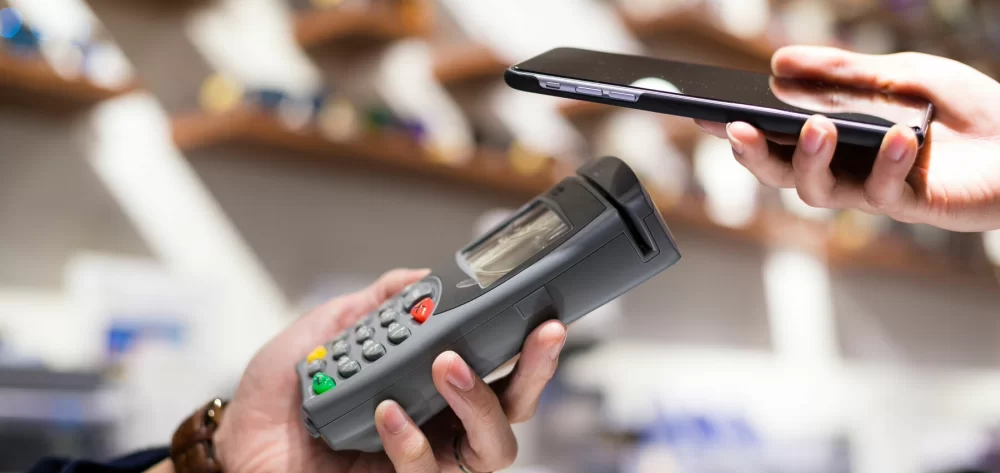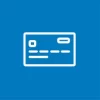Contactless payment has become commonplace in Switzerland. Whether with credit cards, debit cards, phones, or wristwatches, an increasing number of payments are being made in this way.
Contactless payments use NFC technology, which makes it possible to transfer payment information across distances of several centimeters without a physical connection. NFC-enabled cards typically have a symbol with four radio waves printed on them.
In Switzerland, NFC technology lets you make contactless, cashless transactions by credit card, debit card, phone, or wearable device without having to enter a PIN or give your signature. The time savings are practical for both merchants and customers.
120 million contactless payments per month
Currently, more than 8 million of the credit cards and 13 million of the debit cards in circulation across Switzerland are NFC enabled and support contactless payments. That represents around 99 percent of all the cards serviced by Swiss card issuers.
Swiss consumers frequently make contactless payments. Every month, around 100 million debit card transactions and 20 million credit cards transactions are made by tapping to pay, as statistics from the Swiss National Bank (SNB) show. Approximately 84 percent of payments at shops, restaurants, hotels, and vending machines are contactless.
Contactless payments up to 80 francs
Today, contactless payments can be made at most Swiss point of sale terminals, from big retailers to smaller shops, vending machines, and the mobile terminals of food trucks.
Whether or not you have to enter a PIN code to authenticate a payment depends on which kind of payment you are making:
- If you are paying with a credit card, debit card, or wearable payment device, then the following applies: You can always tap to pay regardless of the size of the payment. In Switzerland, you can spend up to 80 francs without having to enter a PIN. If the amount is bigger than 80 francs, then a PIN is required. With the Postfinance debit card, you can make payments of up to 100 francs without entering a PIN at most Swiss merchants. Outside of Switzerland, the limits on how much you can spend without authentication are set by payment networks (like Mastercard and Visa) for each country individually.
- If you are paying with a phone or smartwatch using Apple Pay, Google Pay, or Samsung Pay, then the following applies: You never have to enter a PIN code at the terminal. Instead, you authenticate each payment on your phone or smartwatch. With some mobile payment solutions, you simply have to unlock your phone ahead of making payments.
Mobile payments in Switzerland
Most of the phones now being sold in Switzerland are equipped with NFC, and can be used with mobile payment services like Apple Pay, Google Pay, and Samsung Pay. In order to pay with these mobile payment solutions, you have to link a credit card or debit card. Purchases are then charged to the credit card, prepaid card balance, or to your bank account (debit card).
Most Swiss credit card issuers now support mobile payments. Some only support certain mobile payment services, but not all. You can easily find out which cards work with which mobile wallets using the filters in the interactive Swiss credit card comparison on moneyland.ch. An increasing number of debit cards from Swiss banks now support mobile payments as well.
However, mobile payments are relatively unpopular in Switzerland, as the Swiss payments study shows.
Payments with wristwatches
It is now also possible to make payments using NFC-enabled wristwatches. Wristwatch payment solutions available in Switzerland include Swatch Pay, Fitbit Pay, and Garmin Pay. To use these services, you need to link a credit card or debit card. Whether or not a card can be linked to a payment solution depends on whether or not the service is supported by the card issuer. The credit card comparison on moneyland.ch lets you filter results based on which payment services they support.
Payments with smartwatches and wearables
Some smartwatches and wearables can also be used to make contactless payments. Depending on which smartwatch you have, you can use Apple Pay, Google Pay, or Samsung Pay. Some wearables from Fitbit and Garmin support Fitbit Pay and Garmin Pay respectively.
Which information is shared during a transaction?
When you make a contactless transaction with a card, the card’s number, expiry date, and additional bank-specific codes are transmitted to the POS terminal. While the name of the card holder can technically be shared as well, many card issuers share an alias in place of your name.
When you make a contactless transaction using a mobile payment service, the number of the linked card is not transmitted. These services use tokenization, which means that the phone or watch shares a newly-generated token card number with the terminal.
Data theft from close distances
The growing popularity of contactless payments is creating new risks. Security experts cite a number of existing security breaches. Data thieves can theoretically access information using special equipment such as radio scanners or special programs on NFC-equipped phones.
Data can only be accessed at close distances of several centimeters. Wallets and clothing add additional barriers which can reduce the required distance even further. But with the right equipment, a third party could read data across greater distances.
Inconspicuous data theft is most possible in crowded areas, whether on the street, in malls, or on public transportation. The stolen data can be used to make fraudulent online purchases. But this scenario is primarily a hypothetical one, because data thieves would have to get very close to the card (and presumably, to you) in order to read the data.
Many people today have multiple cards which use NFC or another radio-frequency identification (RFID) standard, such as credit cards, debit cards, a Swisspass for public transportation, and library cards. The signals from different NFC interfaces interfere with each other, which makes it more difficult for thieves to obtain useful data.
The risk of card theft
A much bigger threat is the risk of your NFC-enabled card being stolen or otherwise misappropriated. Due to the high limits for PIN-free contactless spending, a third party can use your card to make numerous, relatively large purchases without having to enter a PIN.
If you notice your card is missing, call the emergency customer service number immediately to have your card frozen, or freeze the account in the app, if that option is available. Some service providers give you the option of deactivating contactless payments via the mobile app or online banking.
Some card issuers reduce the risk by requiring a PIN if a contactless transaction appears to be suspicious.
Report fraudulent purchases immediately
Important: If you meet your due diligence requirements, then the card issuer is responsible for fraudulent purchases by unauthorized third parties. As long as you take all the necessary steps to protect your card and data, and report any fraudulent activity immediately, then the card issuer should cover losses caused by fraudulent transactions.
For that reason, it is important that you check your card statements carefully, report any suspicious transactions as possible fraudulent purchases right away, and have your card frozen immediately.
Take steps to prevent theft
There are a number of steps you can take to reduce the risk of fraud.
- Deactivate the NFC function: Some banks and card issuers let you deactivate contactless transactions. Depending on the service provider, you may be able to deactivate NFC payments via the online banking portal, the mobile app, or customer services. The NFC component remains active even after you deactivate contactless payments, but any payments made this way are rejected.
- Deactivate online payments: If you do not use a card for online payments, you may be able to deactivate online purchases. Some banks and card issuers give you this option. This is beneficial because if fraudsters get ahold of your card data, they will not be able to use it for online spending.
- Set up alerts: If you activate payment alerts, you get informed immediately every time a purchase is made using your card. That enables you to react instantly when a payment occurs that you did not make yourself.
- Use a protective sleeve: Some manufacturers offer protective sleeves or wallets which hinder NFC/RFID transmissions.
More on this topic:
Compare Swiss credit cards now
Compare Swiss prepaid cards now
Compare Swiss private accounts and debit cards now
Mobile payment solutions in Switzerland compared





